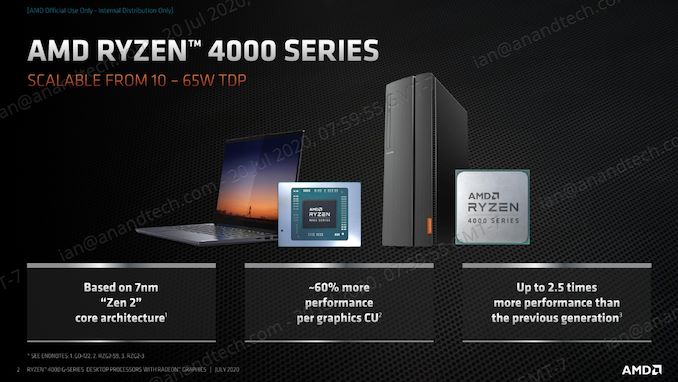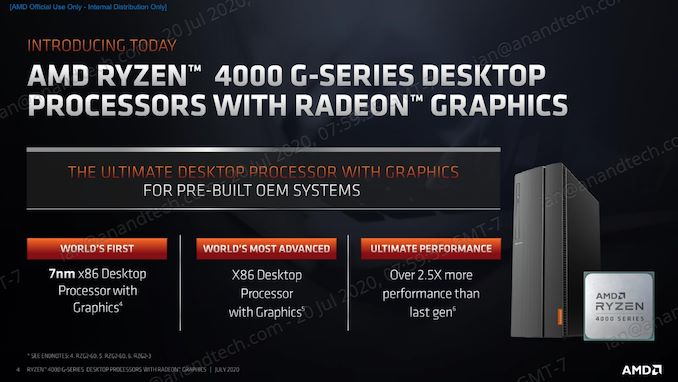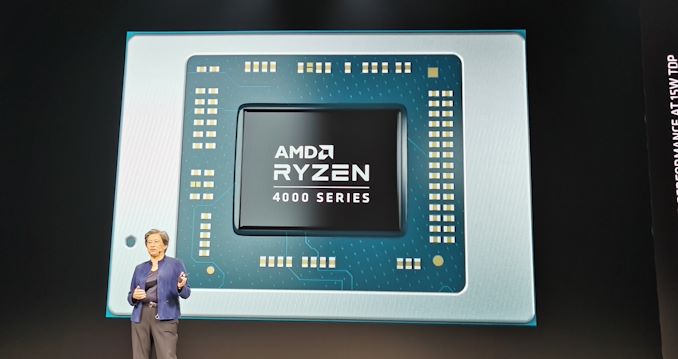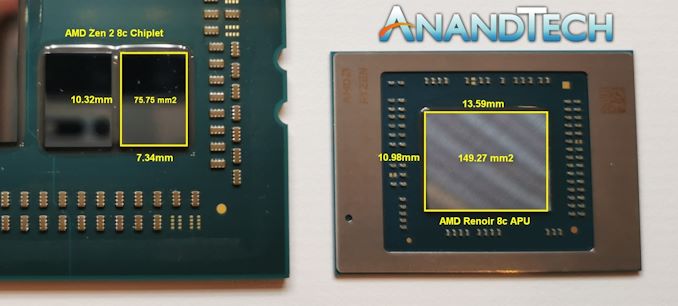AMD Launches 12 Desktop Renoir Ryzen 4000G Series APUs: But You Can’t Buy Them
by Dr. Ian Cutress on July 21, 2020 9:00 AM EST
Today AMD is finally lifting the lid on its long-awaited desktop Zen2 based APU family. Using the same silicon as in the Ryzen Mobile 4000 family, AMD is pumping it up into 35 W and 65 models in the same AM4 platform that is in use today. There has been strong demand from PC builders to release these chips, which were on the topics of forum conversation all the way back at CES. There’s only one downside to these new processors: you can’t buy them on their own. AMD states that the initial release of Ryzen 4000G hardware is for OEMs like Dell and HP only for their pre-built systems.
The new processors use the same 8-core Zen2 plus 8 compute unit Vega that we saw in Ryzen Mobile 4000 at the beginning of the year, but as with previous APU launches, the frequency and power thermals have been pushed up into more manageable desktop environments. To that end, AMD will be launching hardware in the Ryzen 7, Ryzen 5, and Ryzen 3 product lines at both 65 W and 35 W, all on the AM4 platform.
| AMD Ryzen 4000G Series APUs | |||||||
| AnandTech | C/T | Base Freq |
Turbo Freq |
GPU CUs |
GPU Freq |
PCIe * |
TDP |
| Ryzen 4000G | |||||||
| Ryzen 7 4700G | 8 / 16 | 3600 | 4400 | 8 | 2100 | 16+4+4 | 65 W |
| Ryzen 7 4700GE | 8 / 16 | 3100 | 4300 | 8 | 2000 | 16+4+4 | 35 W |
| Ryzen 5 4600G | 6 / 12 | 3700 | 4200 | 7 | 1900 | 16+4+4 | 65 W |
| Ryzen 5 4600GE | 6 / 12 | 3300 | 4200 | 7 | 1900 | 16+4+4 | 35 W |
| Ryzen 3 4300G | 4 / 8 | 3800 | 4000 | 6 | 1700 | 16+4+4 | 65 W |
| Ryzen 3 4300GE | 4 / 8 | 3500 | 4000 | 6 | 1700 | 16+4+4 | 35 W |
| Ryzen Pro 4000G | |||||||
| Ryzen 7 Pro 4700G | 8 / 16 | 3600 | 4400 | 8 | 2100 | 16+4+4 | 65 W |
| Ryzen 7 Pro 4750GE | 8 / 16 | 3100 | 4300 | 8 | 2000 | 16+4+4 | 35 W |
| Ryzen 5 Pro 4650G | 6 / 12 | 3700 | 4200 | 7 | 1900 | 16+4+4 | 65 W |
| Ryzen 5 Pro 4650GE | 6 / 12 | 3300 | 4200 | 7 | 1900 | 16+4+4 | 35 W |
| Ryzen 3 Pro 4350G | 4 / 8 | 3800 | 4000 | 6 | 1700 | 16+4+4 | 65 W |
| Ryzen 3 Pro 4350GE | 4 / 8 | 3500 | 4000 | 6 | 1700 | 16+4+4 | 35 W |
| *PCIe lanes on the SoC are listed in GFX+Chipset+Storage | |||||||
The top processor is the Ryzen 7 4700G, coming in at 65 W TDP with a base frequency of 3.6 GHz and a turbo frequency of 4.4 GHz. It uses all eight compute units for the graphics, running at a mind-numbing 2100 MHz.
At the lower end is the Ryzen 3 4300G, with four cores and eight threads, with a base of 3.8 GHz and a turbo of 4.0 GHz, which should mean that performance is very consistent. This part has six compute units for graphics, running at 1700 MHz.
Every version has a GE counterpart at 35 W, which for the most part reduces the base frequency and TDP only. The exception is the Ryzen 7, where 100 MHz is lost on turbo and 100 MHz is lost on graphics.
All the APUs support DDR4-3200, and have sixteen PCIe 3.0 lanes for add-in cards, as well as four PCIe 3.0 lanes for storage. On the PCIe lanes, the reason this is PCIe 3.0 and not PCIe 4.0 is because the equivalent mobile chip was built with eight PCIe 3.0 lanes for add-in cards, to save on power in a mobile environment. AMD sees these chips being used mostly on their own without a separate discrete graphics card, given that the company already has the Ryzen 3 CPU family for those that want discrete graphics.
At the same time as the Ryzen 4000G APUs, AMD is also launching the Ryzen Pro 4000G versions for the commercial market. These specifications mirror the standard Ryzen counterparts, but fall under AMD’s Pro Technologies feature set, with additional security, manageability, and business ready pillars. This includes full memory encryption and support for DASH management, OS image stability over 18 months, guaranteed processor availability for 24 months, and enhanced QA.
So they are OEM only? What?
Just to be clear, AMD specified OEM and not system integrators (SIs). On our call, AMD clarified that the market for its APUs is skewed very heavily towards the big mass-market prebuilt customers like HP and Dell, rather than custom home builds. The numbers quoted were around 80% of all APU sales end up in these systems, and by working with OEMs only, AMD can also help manage stock levels of the Renoir silicon coming out of the fabs between desktops and notebooks.
What this means is that unless you are choosing to buy a pre-built office-focused business PC, then the only way to get hold of these processors would be through distributors who are selling them piecemeal – AMD is not creating official boxes and bundles with coolers for these processors.
Those pre-built office-focused business PCs are expected to be out shortly. Just in case you control a corporate budget and need a few hundred of them.
Will we ever get Ryzen 4000 APUs for Desktop?
AMD says that they are planning a consumer-grade release of APUs ‘soon’. It was stated in our briefing call that there will be a launch of a future Zen2 APU for the consumer market compatible with 500-series motherboards. The company specifically did not say 400-series, but did clarify that the 4000G series announced today was for 400 and 500 series.
When exactly this launch will come, and what it will be, and what price ranges AMD will be aiming for is unclear. As mentioned, we were discussing Zen 2 based Renoir desktop APUs with vendors back in January, and at this point it certainly feels late to the game. Could AMD be hiding something up its sleeve? A PCIe 4.0 version perhaps (would this require new silicon?) or maybe something up at the 105 W TDP performance level? It really is unclear.
There’s also some new Zen+ APUs
For the lower end of the prebuilt market, AMD is also offering a new set of Zen+ APUs. These are the first desktop parts to carry the Athlon Gold and Athlon Silver branding.
| AMD Athlon 3000G Series | |||||||
| AnandTech | C/T | Base Freq |
Turbo Freq |
GPU CUs |
GPU Freq |
PCIe * |
TDP |
| Athlon 3000G | |||||||
| Athlon Gold 3150G | 4 / 4 | ? | 3900 | 3 | 1100 | 8+4+4 | 65 W |
| Athlon Gold 3150GE | 4 / 4 | ? | 3800 | 3 | 1100 | 8+4+4 | 35 W |
| Athlon Silver 3050GE | 2 / 4 | 3400 | - | 3 | 1100 | 4+2+2 | 35 W |
| Athlon Pro 3000G | |||||||
| Athlon Gold Pro 3150G | 4 / 4 | 3500 | 3900 | 3 | 1100 | 8+4+4 | 65 W |
| Athlon Gold Pro 3150GE | 4 / 4 | 3300 | 3800 | 3 | 1100 | 8+4+4 | 35 W |
| Athlon Silver Pro 3125GE | 2 / 4 | 3400 | - | 3 | 1100 | 4+2+2 | 35 W |
| PCIe lanes on the SoC are listed as GFX+Chipset+Storage | |||||||
We believe these to be based on the same silicon as the Athlon Gold and Athlon Silver mobile parts. We're still waiting on full details for the 3000G family.
The Final Word: We were told that there will be a reviewers’ guide shared with us. Whether that is for these OEM-only parts, or for something upcoming, we don’t know. But we have our fingers crossed.















130 Comments
View All Comments
mdriftmeyer - Wednesday, July 22, 2020 - link
TSMC is now the largest fab in the world.Farfolomew - Tuesday, July 21, 2020 - link
I bet AMD wished they owned their own Fab right about now .... lolBrane2 - Tuesday, July 21, 2020 - link
And have it sink them ?They had it and it didn't work well. They had to be on leading-edge on too many fronts.
Spunjji - Wednesday, July 22, 2020 - link
The fabs they previously owned are now GloFo, which are still on "12nm". I think they're probably quite happy about their decision to spin off that albatross.Nicon0s - Wednesday, July 22, 2020 - link
I doubt it.Irata - Tuesday, July 21, 2020 - link
They are counting on increasing OEM sales for back to school, particularly due to the current pandemic. So OEM have priority.timecop1818 - Tuesday, July 21, 2020 - link
> built on an outdated process nodeI guarantee you, not a single consumer gives a fuck about process node-schmode. What they do care about is getting a stable working platform that allows them to get work done without worrying about their tools. And Intel delivers such experience, while AMD does not.
Spunjji - Wednesday, July 22, 2020 - link
If you're going to bang on about Intel's superiority on a cherry-picked metric, maybe at least cherry-pick one where they're noticeably superior?Wrong_again - Tuesday, July 21, 2020 - link
"All the APUs support DDR4-3200, and have eight PCIe 3.0 lanes."I don't know what's more upsetting, 8 lanes, or the fact that they're Gen 3 lanes. Surely this can't be right. There are AMD laptops with discrete graphics and NVMe support.
PeachNCream - Tuesday, July 21, 2020 - link
NVMe is supported over PCIe 3.0